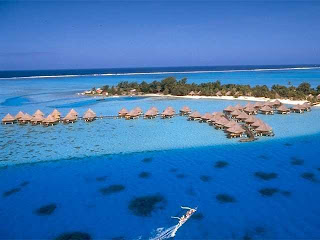
Bora Bora (Society Islands)
 Bora Bora island is possibly the single most famous island in all the world. The legends, mysteries, and romance associated with the words "Bora Bora" bring an almost mystical presence to the island.
Bora Bora island is possibly the single most famous island in all the world. The legends, mysteries, and romance associated with the words "Bora Bora" bring an almost mystical presence to the island.It's true Bora Bora is indeed a wonderful place to vacation... but this magical presence is not so unattainable.
This website seperates the facts from the fiction regarding this wonderful Tahiti Polynesian island paradise: Tourism aspects, activities, practicalities, culture, and all the things you'll want to know
 when planning a trip to Bora Bora. We propose to the would be traveler that the Island of Bora Bora is quite real and attainable as a vacation getaway. Part of the allure has to be its almost unbelievable beauty. Two towering peaks of sheer black rock dominate the center of the island and make an impressive backdrop to an assortment of blue waters that will dazzle the eyes. Bora Bora's lagoon is its most treasured feature, and allows the traveler many opportunities to experience it in a variety of ways. Windsurf, jetski, scuba dive, swim, bask in its warmth... the list goes on.Bora bora is truly an experience worth having. A wonderfully relaxing place to be as well as a great island for you to experience, your Bora Bora vacation will never be forgotten.
when planning a trip to Bora Bora. We propose to the would be traveler that the Island of Bora Bora is quite real and attainable as a vacation getaway. Part of the allure has to be its almost unbelievable beauty. Two towering peaks of sheer black rock dominate the center of the island and make an impressive backdrop to an assortment of blue waters that will dazzle the eyes. Bora Bora's lagoon is its most treasured feature, and allows the traveler many opportunities to experience it in a variety of ways. Windsurf, jetski, scuba dive, swim, bask in its warmth... the list goes on.Bora bora is truly an experience worth having. A wonderfully relaxing place to be as well as a great island for you to experience, your Bora Bora vacation will never be forgotten. The warm shallow water of Bora Bora's lovely lagoon is world famous for its unspoiled beauty. An almost unbroken expanse of warm, white sand surrounds the island, providing it with a white collar of perfection for sun worshippers.
The warm shallow water of Bora Bora's lovely lagoon is world famous for its unspoiled beauty. An almost unbroken expanse of warm, white sand surrounds the island, providing it with a white collar of perfection for sun worshippers.This truly beautiful island lies 240kms north west of Tahiti in the Leeward Society Islands. Home to more than 4,000 people, it is in the centre of a multicoloured lagoon, surrounded by off-shore motu islets inside a protective necklace of coral.
As you approach from the sea or air, you can't help but be awed by the basalt obelisk of Mount Otemanu, a natural sculpture that towers majestically over an island of intense emerald green.

Getting to Bora Bora is easy. A launch takes you from the Bora Bora airport on Motu Mute to the main island, crossing the lagoon to Vaitape Village.



























